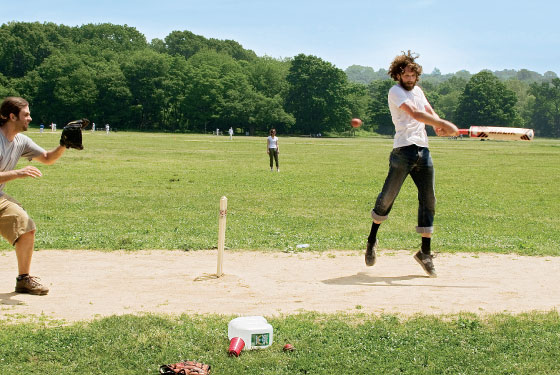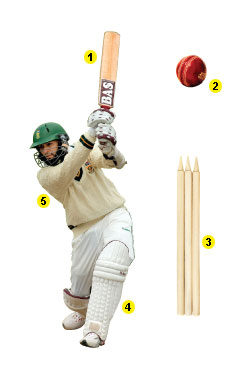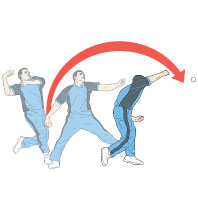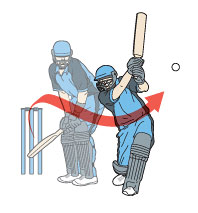
The critical hosannas that greeted Joseph O’Neill’s cricket-infused novel Netherland—The New Yorker’s James Wood called it “one of the most remarkable postcolonial books I have ever read”—had me itching to try the game. The only problem? Even after reading the book, I didn’t understand how to play. So I begged O’Neill to travel north from his Chelsea apartment to a dusty cricket pitch in Van Cortlandt Park in the Bronx on a scorching summer Saturday. There, I thought, he could (attempt to) teach me and two dozen friends the game he loves.
Cricket could, on first glance, be a perfect summer park game. There’s familiar (throw ball, hit ball, run after ball) with a smidge of exotic—oversize flat bats, an enormous oval field, all-white uniforms. More important, it’s slow enough to encourage socializing, with teams taking turns in the field and relaxing with beer coolers in the shade.
After we pounded two sets of wooden stumps into the ground, O’Neill demonstrated the bowling motion (see here). His pitches bounced perfectly in front of the wicket; our attempts sprayed wildly. One actually flew backward. Next, he showed us how to wield a cricket bat, taking a few practice swings and showing impressive, Ichiro-like bat control. Then, after a confusing explanation of the rules—most of us understood very little, except to bellow “How’s that?” every time an out is recorded—O’Neill separated us into teams.
My team, Mr. Kois’s Eleven—“There’s a certain decorum to the sport,” O’Neill explained—took the field first, while my friend James’s team, Mr. Morris’s Eleven, batted. Unlike baseball, with its back-and-forth innings, in cricket the offensive side goes through every one of its at-bats before switching places with the defensive side.
Our match began with James walloping a couple of “sixes,” a cricket equivalent of a home run. O’Neill stood with us for the first hour, umpiring and gritting his teeth, before graciously excusing himself. By the time Mr. Kois’s Eleven had retired the side, we’d been out in the field for 90 heatstroke-inducing minutes and took to bat facing a deficit of 62 runs. (Not a lot by cricketing standards.) We chipped away at the lead, aided by our opponents’ sloppy fielding. My own at-bat was humiliatingly short: I was bowled out (akin to a strikeout) on my second pitch. But our next-to-last batsman was a ringer: Archie, an Englishman who described himself as a “rubbish cricket player” but who in our company was an obvious star. Now down ten runs, we quickly caught up with two fours. Then, down a single run, Archie hit a pop-up that fell between two fielders, scoring two and winning the game for Mr. Kois’s Eleven. The rest of us, well rested from our social hour in the shade, stormed the field, beers spilling everywhere, for a thoroughly American celebration of the walk-off hit.
Fun stuff. But is cricket something that any of us would ever play again? Sure! The fun was in the discovery, the camaraderie, and the beer, not in the fierce competition. Later, I asked O’Neill how our game looked. “How do I put this kindly?” he mused. “I thought that there was no end to your cricketing promise.”
The Gear
Sandra Singh of Singh’s Sporting Goods in Mt. Vernon (347-202-5110) helped us decipher what gear is really necessary for beginners.

1. THE BAT
Made of willow, bats can cost from $35 to $200 (for finer-grained models). You’ll need two, but don’t spend a lot of money; you won’t tell the difference.
2. THE BALL
Leather and rock-hard, real cricket balls run from $7 to $12. To avoid injury in your pickup game, get a couple of the much softer rubber balls ($1.50 each). A tennis ball will also do.
3. THE WICKET
Made of three wooden stumps and two bails—the small crosspieces that rest atop the stumps ($40 a pair). You can’t play without two wickets.
4. THE PADS
A full set of protective gear—arm guard, leg pads, thigh pad, gloves, and helmet—could run you $150. But we played with soft rubber balls, which made these unnecessary.
5. THE CLOTHES
Cricket whites aren’t mandatory, but they’re natty. Get a collared shirt ($35 to $50), a V-neck sweater vest ($25 to $30), and a $10 baseball-style cap.
Where to Play
The city maintains cricket pitches in all five boroughs, nearly half of them in Van Cortlandt Park. On weekends, many fields are reserved by cricket leagues (download a permit at nycgovparks.org; adult groups are charged $10 an hour), but you don’t need a formal pitch to play pickup cricket. Just find a flat, open space, pound your wickets in about 22 yards apart, and mark the edges of a large oval with some cones or shirts.
How To…

BOWL
1. Multistep run-up, ending in a large step with the left foot (assuming you’re a righty). 2. Right arm at back of hip; left arm straight up in the air. 3. Right arm swings overhead without bending elbow. 4. Ball bounces once on the way to the batter.

HIT
1. Bat held pointing down, parallel to the body. 2. Swing depends on the pitch—can be defensive, meant to protect the stumps; tactical, to poke the ball between fielders; or aggressive, a baseball-style swing at a fat pitch. 3. Hold on to the bat as you run back and forth between wickets.